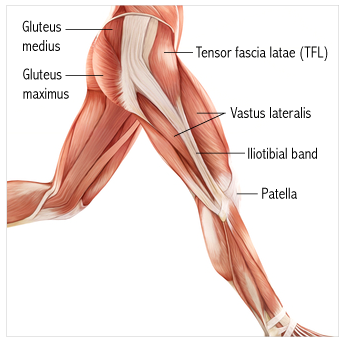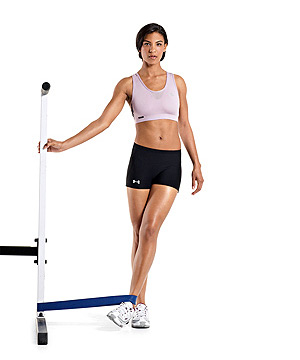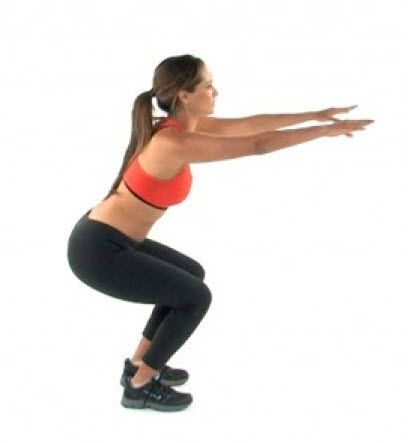The Tensor Fasciae Latae is a muscle, which helps in flexing and abducting the thigh. It becomes very vital for a runner due to this function. If the TFL is consciously kept flexible, it will help in keeping the body injury free as well as being fit. Activities like walking, bending and moving around can get affected if the muscles of the thighs and hip are injured. They will also affect exercise pattern. Tensor Fasciae Latae pain can be caused due to a tear or strain in the muscle. With proper directed exercise, the muscle can be healed and strengthened.

What Are the Symptoms?
The symptoms include:
- Pain in the outer hip
- Referred pain down the outer thigh
- Pain when lying on the affected hip
- When weight bearing on the affected side, the pain worsens
The trigger points for TFL myofascial can get misdiagnosed as trochanteric bursitis because they have very similar symptoms. In the beginning the treatment for either case should be to get the surrounding muscles in good condition and make corrections in existing imbalance in the muscles. If the case persists, it should be investigated for bursa involvement.
What Causes Pain and Injury?
Tensor fasciae latae and Iliotibial band muscle pain can be caused due to the following activities:
Running, climbing, cycling, dancing, excessive walking when not in shape and playing court sports like basketball, volleyball and tennis.
How to Relieve Tensor Fasciae Latae Pain
Therapies
- Warm and Cold Therapy Gel: A pain relieving gel, which provides therapeutic warmth with burning, can be used. Or else a cooling gel, which reduces inflammation by cooling the area. The gel should be applied on the outside of thighs and knees. It will help in reducing the pain as well as tightness.
- Hot and Cold Compress/Wrap: This kind of wraps can be used on thighs, knee, hip and back. It can be cooled in the freezer or heated in the microwave. It helps in reducing the pain and swelling in the injured muscle by cold therapy and chronic pain and swelling by warm therapy.
- Tensor Fasciae Latae Brace and Support: This brace is useful in providing compression and support to the TLF muscle. This type of support can be used in high thigh and groin injuries as well. The brace is held in place by wrapping around thigh and abdomen.
- Compression Leggings: Compression leggings are usually used for preventing injuries, however, they are excellent when used as support for injured muscle. They help in reducing swelling as well. Good compression leggings cover the thighs and end below the knee. Tight compression at lower end of limb and decreased compression at top is essential for reducing inflammation and circulation.
- Massage Tools for Self Treatment: A roller is an excellent massage tool, which can be used on upper and lower leg muscles. It is easy to use and helps in relieving tension and pain. It just needs to be rolled up and down the muscle and usually does not strain the hands and wrists.
Stretching and Strengthening Exercise for Tensor Fasciae Latae Pain
Some exercises are described below which help in strengthening the muscles and dealing with the pain.
- Outer Hip Stretch
 Start by lying down on the back, and bend your right knee. Cross the bent leg over the left knee and pull with your left hand. Hold this position for 10 to 30 seconds. This exercise stretches the gluteus medius, gluteus minimus and tensor fascia latae muscles.
Start by lying down on the back, and bend your right knee. Cross the bent leg over the left knee and pull with your left hand. Hold this position for 10 to 30 seconds. This exercise stretches the gluteus medius, gluteus minimus and tensor fascia latae muscles.
- Standing Outer Hip Stretch
 Start by placing the leg to be stretched behind the other leg. Lean your body on the side, which is not going to be stretched. The hip to be stretched should be pushed out to the other side. Hold for 10 – 30 seconds. The muscles stretched in the exercise are TFL, Iliotibial band and Sartorius.
Start by placing the leg to be stretched behind the other leg. Lean your body on the side, which is not going to be stretched. The hip to be stretched should be pushed out to the other side. Hold for 10 – 30 seconds. The muscles stretched in the exercise are TFL, Iliotibial band and Sartorius.
- Hip Abduction with Band
 This exercise is done to strengthen the hip abductors present on the outside of the joint. To start wrap a resistance band around the ankle and other end to a doorway or chair leg. Stretch the leg outside, as far as possible and slowly come back to position. Muscles stretched in this exercise are TFL, Gluteus medius and gluteus minimus.
This exercise is done to strengthen the hip abductors present on the outside of the joint. To start wrap a resistance band around the ankle and other end to a doorway or chair leg. Stretch the leg outside, as far as possible and slowly come back to position. Muscles stretched in this exercise are TFL, Gluteus medius and gluteus minimus.
- TFL Trigger Pointing
 A trained person should help you in this exercise. A massage ball is laid on the bad side, under the TFL and moved around. It helps in identifying the painful or sensitive spot. The pressure is maintained for 10 – 15 seconds till the tenderness decreases. It should be done twice in the beginning, and repeated every 2-3 hours.
A trained person should help you in this exercise. A massage ball is laid on the bad side, under the TFL and moved around. It helps in identifying the painful or sensitive spot. The pressure is maintained for 10 – 15 seconds till the tenderness decreases. It should be done twice in the beginning, and repeated every 2-3 hours.
- Squatting Exercise
 Squats are helpful in strengthening the TFL muscle and also in increasing the hip rotation and flexion. To start stand with the feet at shoulder distance, keep the back straight and abdominal muscles pulled in. Bend your knees while pushing the butt out, till your thighs are parallel to the floor. Push upwards from the heels and stand straight. This can be done 5 to 10 times.
Squats are helpful in strengthening the TFL muscle and also in increasing the hip rotation and flexion. To start stand with the feet at shoulder distance, keep the back straight and abdominal muscles pulled in. Bend your knees while pushing the butt out, till your thighs are parallel to the floor. Push upwards from the heels and stand straight. This can be done 5 to 10 times.
Watch this video to learn how to stretch TFL (tensor fascia latae) the right way to relieve tensor fasciae latae pain.
